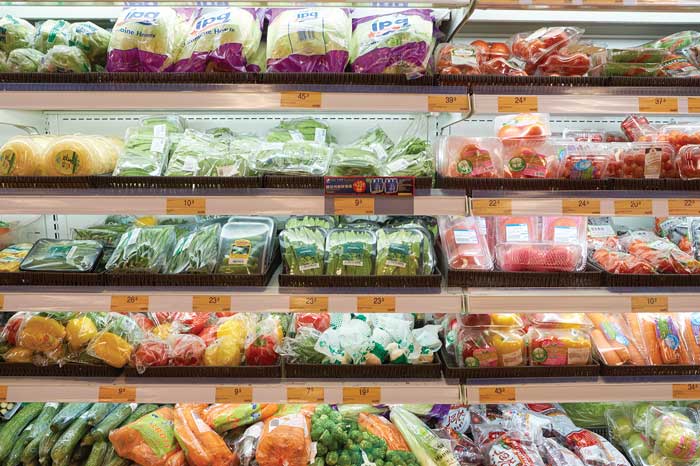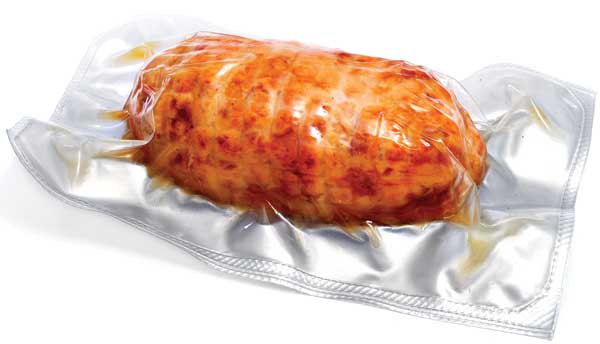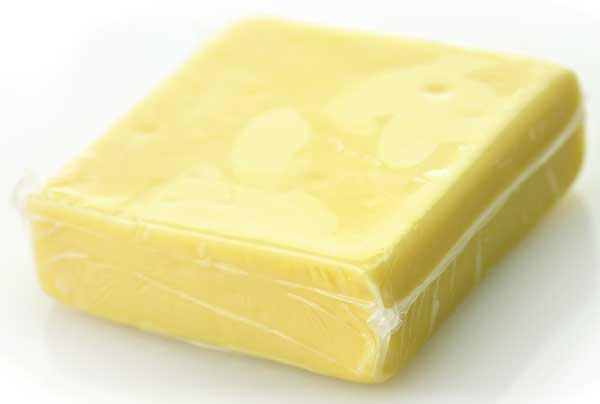Raising the Bar: High-Barrier Polymers
PACKAGING
 The growing demand to limit the use of preservatives in food is catalyzing increased interest in high-barrier packaging. When food manufacturers use fewer preservatives, the food packaging needs to protect the food by reducing rates of oxidation and microbial growth. This often requires enhanced barriers to oxygen and water vapor to maintain or increase the shelf life of food products. Extending the shelf life of packaged foods enables high-volume production with reduced changeovers, less food waste, and an expanded distribution network. Technologies that extend shelf life, such as modified atmosphere packaging and high-pressure processing (HPP), need high-barrier packaging. Polymers used in high-barrier packaging are created by decreasing the rate of permeation using the inherent properties of polymers, increasing the permeant diffusion path, and applying coatings and multilayer structures (laminations and extrusions).
The growing demand to limit the use of preservatives in food is catalyzing increased interest in high-barrier packaging. When food manufacturers use fewer preservatives, the food packaging needs to protect the food by reducing rates of oxidation and microbial growth. This often requires enhanced barriers to oxygen and water vapor to maintain or increase the shelf life of food products. Extending the shelf life of packaged foods enables high-volume production with reduced changeovers, less food waste, and an expanded distribution network. Technologies that extend shelf life, such as modified atmosphere packaging and high-pressure processing (HPP), need high-barrier packaging. Polymers used in high-barrier packaging are created by decreasing the rate of permeation using the inherent properties of polymers, increasing the permeant diffusion path, and applying coatings and multilayer structures (laminations and extrusions).
Permeant Gases and Measurements
Designing high-barrier packaging requires an understanding of the factors that govern permeability. These factors include permeant gases and measurements, glass transition temperature, solubility, and diffusion. Permeability involves the transfer of gases across a barrier. Gases commonly of concern in food packaging are oxygen, water vapor, and carbon dioxide, and these transmission rates are known as O2TR, WVTR, and CO2TR, respectively. Transmission rates vary between gases, and this allows for practical packaging production applications. For example, a one-pound cheese brick package can be created by filling package headspace with carbon dioxide before sealing the package. A vacuum brick package is created when carbon dioxide permeates out of the package faster than oxygen comes into the package. This happens because the carbon dioxide within the package is much lower than the carbon dioxide outside the package and is nonpolar. For different foods, the concentration of carbon dioxide is modulated, depending on the degree of vacuum pack needed and distribution range. In a high-barrier package, gases within packaging contract in frozen environments and expand at high altitude.
 Transmission of gases also varies as a function of the relative humidity and temperature. The water vapor permeability (WVP) value incorporates these factors. WVP incorporates partial pressure difference, accounting for temperature and relative humidity differences as well as thickness. Water vapor permeability is commonly in units of gram × mils / m2 × day × mmHg whereas the WVTR is the measure of the weight of water vapor transferred in a unit of time over a package area and commonly in units of gram / m2 × day. The American Society for Testing Materials (ASTM) and the International Organization for Standardizations (ISO) have standards for measuring water vapor transmission, including ASTM D1653, ASTM E96, ASTM F1249, and ISO 15106-2. Other standard methods exist for argon, carbon dioxide, ethylene, hydrogen, and nitrogen.
Transmission of gases also varies as a function of the relative humidity and temperature. The water vapor permeability (WVP) value incorporates these factors. WVP incorporates partial pressure difference, accounting for temperature and relative humidity differences as well as thickness. Water vapor permeability is commonly in units of gram × mils / m2 × day × mmHg whereas the WVTR is the measure of the weight of water vapor transferred in a unit of time over a package area and commonly in units of gram / m2 × day. The American Society for Testing Materials (ASTM) and the International Organization for Standardizations (ISO) have standards for measuring water vapor transmission, including ASTM D1653, ASTM E96, ASTM F1249, and ISO 15106-2. Other standard methods exist for argon, carbon dioxide, ethylene, hydrogen, and nitrogen.
Glass Transition Temperature
While water vapor permeability provides a more realistic view of polymer properties, the relationship between temperature and rate of transfer does not always follow an Arrhenius relationship. This is because permeability is lower when polymers are more crystalline below their glass transition temperature (Tg) and higher when polymers are more amorphous above the Tg. Interestingly, this is the same Tg that is used in food product development to finesse product formulations. Many polymers used in food packaging are often used above and below their Tg. For example, when polypropylene containers are hot filled at 190° F, this is above the 17° F Tg of polypropylene, and when these same containers are shipped in cold temperatures, they are often below the Tg. Above the Tg, polypropylene is more permeable, and below the Tg, polypropylene is less permeable and more brittle, resulting in stress cracking in the package. For this reason, polypropylene is commonly copolymerized with polyethylene that has a Tg of -148° F and is in an amorphous state when used in food packaging. But this copolymerized polypropylene-polyethylene does not withstand most hot-fill temperatures. Processing at temperatures above and below the Tg also impacts the amount of permeant transferring through the structure during processing. For example, package structures are optimized for permeability during the different processing temperatures for HPP and retort environments. The change in permeability above and below Tg impacts the ability of polymers to protect food. For example, polymers can be selected to enable more oxygen and carbon dioxide transfer as the temperature increases for packaged produce. This allows the package to control the respiration of produce as the temperature increases.
 Solubility and Diffusion
Solubility and Diffusion
Permeation is governed by many factors inherent to polymers. Mathematically, permeability is determined by multiplying diffusion and solubility coefficients. Thus, understanding the impact of these two factors (diffusion and solubility) allows an understanding of efforts to increase the barrier properties of polymers. In the design of high-barrier packaging, solubility relates to the degree at which permeants such as oxygen, water vapor, and carbon dioxide can be dissolved in the polymer structure. This is relevant in processing and during shelf life. For example, during HPP, the increased pressure results in sorption of water vapor into the polymer structure. This retained moisture fundamentally alters the polymer structure. To assess the solubility of high pressure water in polymers, Langmuir-Henry’s law equation is applied. Understanding these relationships has allowed innovation to create barriers specific to applications such as HPP.
Likewise, high temperature processing in a retort requires a polymer resistant to moisture and oxygen at high temperatures. Interestingly, hygroscopic films such as ethylene vinyl alcohol and many bio-derived compostables swell during water vapor exposure and the solubility of water vapor in these polymers is a function of the concentration of the water within the polymer. In these cases, Langmuir-Henry’s law is not applicable, but the Flory-Huggins relationship is. Once the permeant has absorbed into the surface of the polymer, diffusion through the polymer is relevant. Diffusion is the rate of transfer of a permeant within the actual structure. As a general guide in selecting barrier for a specific food, information on the O2TR, WVTR, and CO2TR at the actual conditions of use and the permeability facilitates better decision-making.
Technology to Achieve Barrier Polymers
Besides the common approach of multilayer structures, obtaining a high-barrier polymer involves three methods: 1) use of an inherently chemically complex polymer that inhibits permeation, 2) increasing the path for diffusion by creating a maze or tortuous path within the polymer, and 3) decreasing the solubility of high-barrier coatings.
Optimized functional groups and crystallinity achieve high-barrier polymers. For example, the methyl group in polypropylene restricts permeation more than the hydrogen group within low-density polyethylene films used for bread packaging. However, the high crystallinity of high-density polyethylene, commonly used for milk jugs, which also contains a hydrogen group, gives high-density polyethylene an oxygen barrier comparable to polypropylene and much better than low-density polyethylene. High-barrier polymers such as polyethylene terephthalate incorporate functional groups and low solubility coefficients. Polyethylene terephthalate provides a barrier suitable to keep carbon dioxide in bottles containing carbonated beverages. In contrast, the water vapor barrier properties of polylactic acid are two orders of magnitude worse than polyethylene terephthalate.
Creating a tortuous path to inhibit permeant diffusion through polymers is not a new concept. However, recent progress in the use of nanoparticles permits a higher efficacy per unit volume ratio than with larger size particles. Manufacturers are now able to inhibit clumping and clustering of nanoparticles within a polymer, and this allows enhanced barrier properties with fewer nanoparticles. This innovation has resulted in using 25% less nanocomposites in a polymer with no reduction of permeation. As a result, the amount and cost of incorporating nanoparticles in packaging is less.
Coating polymers to improve barrier properties has evolved from thick metal coatings. Metallized coatings employ plasma-enhanced chemical vapor deposition to achieve a nanocoating. Alternatives to this process are advancing rapidly and enhance recyclability. Atomic layer deposition is a more precise version of metallizing and utilizes ordered nanotubular arrays, nanorods, nanopillars, and nanochannels. This level of precision can result in a single structure having controllable barrier properties, which may translate into consistent production settings and high economies of scale in polymer production. In a manner similar to the use of atomic layer deposition, new application technology has led to the reassessment of glass-coated films.
High-Barrier Layers in Polymers
Laminations, coextrusions, and coatings decrease the solubility and diffusion of high-barrier polymers. These layered polymers are common in packaging because of the cost savings and capabilities (such as improved sealing) that they provide. For example, both the seal layer and the barrier layer can be optimized to form a reliable high-barrier package. Typical laminate high-barrier structures include ethylene vinyl alcohol or polyvinylidene chloride as a barrier layer. Ethylene vinyl alcohol is highly soluble in water vapor and is most commonly protected by polypropylene or another moisture barrier. Nylon is often incorporated to supply puncture resistance. A seal layer of a polymer with a high flow to caulk and seal is also needed. Peelable seals in high-barrier structures, which is used in packaging such as the HPP-processed Hormel Natural Choice deli meats, are achieved by blending seal contact polymers or with patterns as in Südpak’s Multipeel. Because a seal layer is often combined with a high-barrier and puncture-resistant structure, a laminate structure usually consists of many layers to achieve optimal integrity of the barrier and seal. For example, a typical laminate structure is an inner seal layer, a nylon, an adhesive or tie layer, ethylene vinyl alcohol, an adhesive or tie layer, and reverse-printed polypropylene. A peelable cheese stick polymer barrier consists of a formable water-quenched extrusion structure of polyethylene, ethylene vinyl alcohol, nylon, and polypropylene and a top flat laminate film composed of reverse-printed polyethylene terephthalate, adhesive, ethylene vinyl alcohol, and polyethylene.
 Claire Koelsch Sand, PhD, Contributing Editor
Claire Koelsch Sand, PhD, Contributing Editor
President, Packaging Technology and Research
Adjunct Professor, Michigan State Univ.
[email protected]
